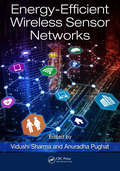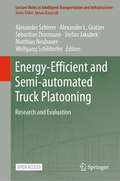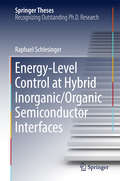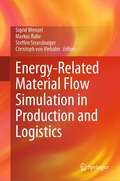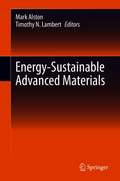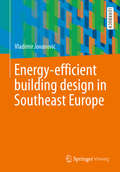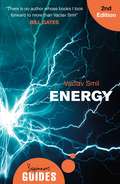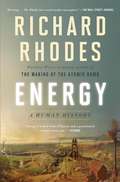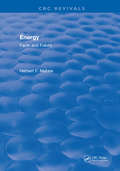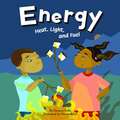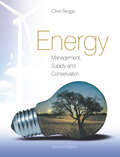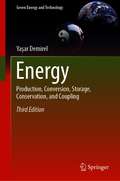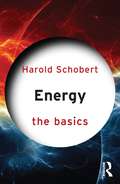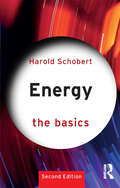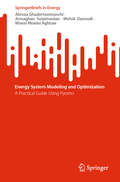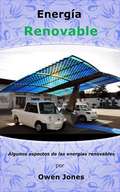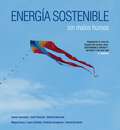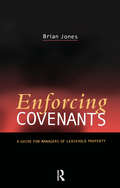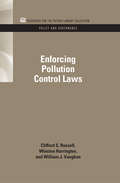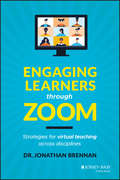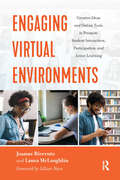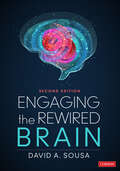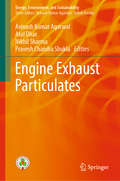- Table View
- List View
Energy-Efficient Wireless Sensor Networks
by Vidushi Sharma Anuradha PughatThe advances in low-power electronic devices integrated with wireless communication capabilities are one of recent areas of research in the field of Wireless Sensor Networks (WSNs). One of the major challenges in WSNs is uniform and least energy dissipation while increasing the lifetime of the network. This is the first book that introduces the energy efficient wireless sensor network techniques and protocols. The text covers the theoretical as well as the practical requirements to conduct and trigger new experiments and project ideas. The advanced techniques will help in industrial problem solving for energy-hungry wireless sensor network applications.
Energy-Efficient and Semi-automated Truck Platooning: Research and Evaluation (Lecture Notes in Intelligent Transportation and Infrastructure)
by Stefan Jakubek Alexander Schirrer Matthias Neubauer Alexander L. Gratzer Sebastian Thormann Wolfgang SchildorferThis open access book presents research and evaluation results of the Austrian flagship project “Connecting Austria,” illustrating the wide range of research needs and questions that arise when semi-automated truck platooning is deployed in Austria. The work presented is introduced in the context of work in similar research areas around the world. This interdisciplinary research effort considers aspects of engineering, road-vehicle and infrastructure technologies, traffic management and optimization, traffic safety, and psychology, as well as potential economic effects. The book’s broad perspective means that readers interested in current and state-of-the-art methods and techniques for the realization of semi-automated driving and with either an engineering background or with a less technical background gain a comprehensive picture of this important subject. The contributors address many questions such as: Which maneuvers does a platoon typically have to carry out, and how?How can platoons be integrated seamlessly in the traffic flow without becoming an obstacle to individual road users? What trade-offs between system information (sensors, communication effort, etc.) and efficiency are realistic? How can intersections be passed by a platoon in an intelligent fashion? Consideration of diverse disciplines and highlighting their meaning for semi-automated truck platooning, together with the highlighting of necessary research and evaluation patterns to address such a broad task scientifically, makes Energy-Efficient and Semi-automated Truck Platooning a unique contribution with methods that can be extended and adapted beyond the geographical area of the research reported.
Energy-Level Control at Hybrid Inorganic/Organic Semiconductor Interfaces
by Raphael SchlesingerThis work investigates the energy-level alignment of hybrid inorganic/organic systems (HIOS) comprising ZnO as the major inorganic semiconductor. In addition to offering essential insights, the thesis demonstrates HIOS energy-level alignment tuning within an unprecedented energy range. (Sub)monolayers of organic molecular donors and acceptors are introduced as an interlayer to modify HIOS interface-energy levels. By studying numerous HIOS with varying properties, the author derives generally valid systematic insights into the fundamental processes at work. In addition to molecular pinning levels, he identifies adsorption-induced band bending and gap-state density of states as playing a crucial role in the interlayer-modified energy-level alignment, thus laying the foundation for rationally controlling HIOS interface electronic properties. The thesis also presents quantitative descriptions of many aspects of the processes, opening the door for innovative HIOS interfaces and for future applications of ZnO in electronic devices.
Energy-Related Material Flow Simulation in Production and Logistics
by Markus Rabe Sigrid Wenzel Steffen Strassburger Christoph Von ViebahnThis book provides for the first time an overview on the current approaches and applications of energy aspects in production and logistics by the use of simulation techniques. During the last decade, the importance of energy in the material flow processes has become more and more important. The pressure to reduce the environmental footprint of production and logistics systems will even intensify in future. Therefore, enterprises have started to integrate the use of energy into their planning processes much more than before, even designing feedback loops, e.g., from energy control to production control. This receives additional attention with the increasing use of renewable, but less reliable, energy sources. Care must be taken to establish processes that aim to use energy when it is available. As an example, many industrial processes like melting or coating have significant energy demands, but could vary the point of time of its consumption within specific limits, leading to a very high complexity. It discusses the construction and application of energy-specific performance indicators and analyzes the input information that needs to be acquired before implementing suitable models. On this basis, concrete technical solutions are introduced.
Energy-Sustainable Advanced Materials
by Mark Alston Timothy N. LambertThis book highlights progress towards the capture, storage, and utilization of energy through the development of advanced materials and systems based on abundant elements, materials, and commodities. Energy is critical to human sustainability and a global-scale deployment of renewable energy systems will be required. Hence, the chapters integrate the fundamental aspects that enable the technical advancements in detail, along with an emphasis on the need for highly sustainable materials to enable real impact for humankind: To determine innovation of energy capture and storage through characterizations of materials in areas of electrical generation and electrical storage systems; To demonstrate better performance, economic and environmental advantages than the current state of the art; To define new chemistries and materials for innovations in energy density design through lower operational temperatures, improve safety, expanding operational voltage, battery durability lifetimes, and reduce system costs. Advances critical technical and commercial objectives for novel high energy density materials;Evaluates operational material models for optimizing energy capture that are integrated by configurations as a system; Illustrates utilization of material life cycle assessment for high energy outputs generators for sustainable materials.
Energy-efficient building design in Southeast Europe
by Vladimir JovanovićThe aim of this textbook is to improve conventional building design in Southeast Europe. This is done with proposing conceptual guidelines for designing energy-efficient buildings for different geographic regions of Serbia. The focus is on climate-appropriate design of building envelopes. To adress sustainability, economical, environmental and social aspects are evaluated. The body is divided into three main chapters: traditional houses, the existing housing stock, and design patterns for future buildings. The conclusions and the methodology can be applied in the rest of Southeast Europe, since Serbia has a unique position in the middle of the region, covering different geographical areas that spread far out of Serbia’s borders.
Energy: A Beginner's Guide (Beginner's Guides)
by Vaclav SmilWith one famous equation, E=mc2, Einstein proved all matter can be described as energy. It is everywhere and it is everything. In this newly updated and engaging introduction, renowned scientist Vaclav Smil explores energy in all its facets – from the inner workings of the human body to what we eat, the car we drive and the race for more efficient and eco-friendly fuels. Energy: A Beginner's Guide highlights the importance of energy in both past and present societies, by shedding light on the science behind global warming and efforts to prevent it, and by revealing how our daily decisions affect energy consumption. Whether you're looking for dinner table conversation or to further your own understanding, this book will amaze and inform, uncovering the truths and exposing the myths behind one of the most important concepts in our universe.
Energy: A Human History
by Richard RhodesPulitzer Prize- and National Book Award-winning author Richard Rhodes reveals the fascinating history behind energy transitions over time—wood to coal to oil to electricity and beyond.People have lived and died, businesses have prospered and failed, and nations have risen to world power and declined, all over energy challenges. Ultimately, the history of these challenges tells the story of humanity itself. Through an unforgettable cast of characters, Pulitzer Prize-winning author Richard Rhodes explains how wood gave way to coal and coal made room for oil, as we now turn to natural gas, nuclear power, and renewable energy. Rhodes looks back on five centuries of progress, through such influential figures as Queen Elizabeth I, King James I, Benjamin Franklin, Herman Melville, John D. Rockefeller, and Henry Ford. In Energy, Rhodes highlights the successes and failures that led to each breakthrough in energy production; from animal and waterpower to the steam engine, from internal-combustion to the electric motor. He addresses how we learned from such challenges, mastered their transitions, and capitalized on their opportunities. Rhodes also looks at the current energy landscape, with a focus on how wind energy is competing for dominance with cast supplies of coal and natural gas. He also addresses the specter of global warming, and a population hurtling towards ten billion by 2100. Human beings have confronted the problem of how to draw life from raw material since the beginning of time. Each invention, each discovery, each adaptation brought further challenges, and through such transformations, we arrived at where we are today. In Rhodes’s singular style, Energy details how this knowledge of our history can inform our way tomorrow.
Energy: Facts and Future
by Herbert F. MatareThis review is supposed to supply to the reader the necessary facts to judge where we stand today in terms of the energy crisis, and what has to be done to save humanity from a catastrophic energy shortage.
Energy: Heat, Light, and Fuel
by Darlene R. Stille Sheree BoydThe forms of energy discussed include chemical energy, kinetic energy, and solar energy.
Energy: Management, Supply And Conservation
by Clive BeggsEnergy – its source, security, price, and the efficiency of its use, are increasingly important issues for a diverse range of people. 'Energy: Management, Supply and Conservation' is a comprehensive text dealing with the theory and practice of the supply of energy, energy management and auditing, and the design of sustainable energy facilities. It considers the systems needed to create low-energy, sustainable buildings, including passive solar design, energy-efficient heating and air-conditioning, and combined heat and power. In addition the book includes substantial sections on renewable energy, transport energy, and energy economics. This new edition includes the latest in alternate-energy technology, for example wind turbines and solar panels as well as updating important energy values and statistics. The book’s readable style, along with its many figures, tables and worked examples make it an ideal text for courses on energy management, environmental engineering, architectural engineering and building services engineering. It will also be useful as a definitive handbook for professionals in the environmental, construction, utilities and facilities management sectors, as well as being of interest to those involved in sustainability economics and environmental policy making. Clive Beggs is Professor of Medical Technology at the University of Bradford. He is both a mechanical engineer and a biomedical scientist, who for many years has had an interest in ways in which energy is utilized and consumed. He is an expert in the fields of energy management and low energy building design, with many years experience of the design and installation of mechanical services within the construction industry. He is a well known international speaker and is author of many scientific papers on low energy and environmentally friendly building design. He is a holder of the CIBSE Carter Bronze Medal for his work on desiccant cooling.
Energy: Production, Conversion, Storage, Conservation, and Coupling (Green Energy and Technology)
by Yaşar DemirelThis revised and updated 3rd edition of the book allows readers to develop a practical understanding of the major aspects of energy. It also includes two new chapters addressing renewable energy, and energy management and economics. The book begins by introducing basic definitions, and then moves on to discuss the primary and secondary energy types, internal energy and enthalpy, and energy balance, heat of reaction and heat transfer. Each chapter features fully solved example problems and practice problems to support learning and the application of the topics discussed, including: energy production and conversion; energy conservation; energy storage; energy coupling; sustainability in energy systems; renewable energy; and energy management and economics. Written for students across a range of engineering and science disciplines, the book provides a comprehensive study guide. It is particularly suitable for courses in energy technology, sustainable energy technologies and energy conversion & management, and offers an ideal reference text for students, engineers, energy researchers and industry professionals.A updated solutions manual to this textbook's problems ais available to course instructors on request from the author and online on www.springer.com.
Energy: The Basics (The Basics)
by Harold SchobertPeople rarely stop to think about where the energy they use to power their everyday lives comes from and when they do it is often to ask a worried question: is mankind’s energy usage killing the planet? How do we deal with nuclear waste? What happens when the oil runs out? Energy: The Basics answers these questions but it also does much more. In this engaging yet even-handed introduction, readers are introduced to: the concept of ‘energy’ and what it really means the ways energy is currently generated and the sources used new and emerging energy technologies such as solar power and biofuels the impacts of energy use on the environment including climate change Featuring explanatory diagrams, tables, a glossary and an extensive further reading list, this book is the ideal starting point for anyone interested in the impact and future of the world’s energy supply.
Energy: The Basics (The Basics)
by Harold SchobertEnergy: The Basics offers a concise and engaging introduction to energy, answering critical questions and providing accessible definitions of essential concepts and developments in the field.People rarely stop to think about where the energy they use to power their everyday lives comes from and when they do it is often to ask a worried question: is mankind’s energy usage killing the planet? How do we deal with nuclear waste? What happens when the oil runs out? Energy: The Basics answers these questions, but it also does much more. In this engaging yet even-handed introduction, readers are introduced to: the concept of ‘energy’ and what it really means the ways energy is currently generated and the sources used new and emerging energy technologies such as solar power and biofuels the impacts of energy use on the environment including climate change This new edition has been updated throughout and includes a new chapter on energy storage, along with new material on transportation energy and batteries.Featuring explanatory diagrams and an extensive further reading list, this book is the ideal starting point for anyone interested in the impact and future of the world’s energy supply.
Energy System Modeling and Optimization: A Practical Guide Using Pyomo (SpringerBriefs in Energy)
by Alireza Ghadertootoonchi Armaghan Solaimanian Mehdi Davoudi Moein Moeini AghtaieThis brief serves as a comprehensive and practical guide to energy system optimization utilizing the Pyomo optimization package in Python. It thoroughly explains the mathematical foundations of energy system technologies and how to employ Pyomo for addressing optimization challenges. The book highlights the significance of energy system optimization in terms of economic and environmental impacts, followed by a detailed exploration of Pyomo, an advanced mathematical programming language. It covers a wide spectrum of problem types, introducing various open-source solvers and outlining the steps involved in developing Python-based Pyomo code to solve optimization problems. Furthermore, the book provides mathematical formulations and Python code for diverse energy technologies, including thermal power plants, renewable energy sources like wind and solar, power transmission lines, and electricity storage systems. It also discusses topics like reliability, load loss, demand-side flexibility, and linearization techniques. To demonstrate practical application, the book offers a case study that progressively builds in complexity, guiding readers in optimizing intricate energy systems based on the models and constraints explained earlier. Targeted at professionals, researchers, and students, it is suitable for those with a foundational understanding of Python and mathematical optimization, and it underscores the crucial role of energy system optimization in addressing contemporary energy sector concerns such as environmental impact reduction and sustainable development.
Energía Renovable: Algunos aspectos de las energías renovables (Cómo hacer... #85)
by Owen JonesEnergía Renovable Algunos aspectos de las energías renovables Espero que la información le resulte útil, precisa y rentable. La información de este libro electrónico sobre cómo implementar una estrategia de energía sostenible en el hogar está organizada en 19 capítulos de aproximadamente 500 a 600 palabras cada uno. Espero que sea de interés para aquellos que quieran hacer algo para crear su propia energía para uso doméstico. Como beneficio adicional, le otorgo permiso para usar el contenido en su propio sitio web o en sus propios blogs y boletines, aunque es mejor si los reescribe primero con sus propias palabras. También puede dividir el libro y revender los artículos. De hecho, el único derecho que no tiene es revender o regalar el libro tal como se le entregó.
Energía sostenible sin malos humos (without the hot air #7)
by Javier Samanes Pascual Julio Pascual Miqueleiz Alberto Berrueta Irigoyen Miguel Araiz Vega Leyre Catalán Ros Patricia Aranguren Garacochea David Arricibita de AndrésThe paperback edition of this book is published by UPNA - the Public University of Navarre. The ebook editions are distributed by UIT, and are available at zero cost from the usual ebook online retailers. El recurso renovable es «enorme», pero nuestro consumo también es «enorme». Para comparar cosas «enormes» necesitamos números, no adjetivos. Este libro acaba con todas las afirmaciones contradictorias de la prensa, gobiernos y grupos de presión sea cual sea su ideología. Te ofrece los números y hechos que necesitas, en porciones fáciles de digerir, para que puedas entender el problema y construir tus propias conclusiones. Este libro ha sido escrito por un grupo de siete profesores e investigadores de la Universidad Pública de Navarra, de las áreas de ingeniería eléctrica y térmica, unidos por las energías renovables.
Enforcing Covenants
by Brian JonesEnforcing Covenants focuses on the measures which managers of residential leasehold property can deploy to encourage leaseholders and other parties to abide by their contractual obligations with a view to achieving the most effective management of their estates and developments. In particular, the book concentrates on the changes to the law introduced by the Commonhold and Leasehold Reform Act 2002. Enforcing obligations in leases has never been easy, and the 2002 Act has made it even more onerous for the hard pressed property manager. Very few will be able to avoid having to take enforcement action, especially when bringing in the funds to make management feasible. Subjects examined in this book include: the new rules on forfeiture the new rules on ground rents service charge recovery enforcing county court judgments the new procedures and jurisdictions of the Leasehold Valuation Tribunals enforcing repairs neighbour disputes and nuisance cases injunctions and specific performance costs and administration charges alternative dispute resolution. Enforcing Covenants is essential reading for anyone involved in the management of property, whether they be professionals or lay directors of residents management companies. As well as examining the relevant law and decisions of the Leasehold Valuation Tribunals, the book provides much practical guidance on rules and procedures, illustrated by precedent forms and notices and backed up by some light-hearted case studies.
Enforcing Pollution Control Laws (RFF Policy and Governance Set)
by Winston Harrington Clifford S. Russell William J. VaughnEconomic models are used to show the extent of the difficulties involved in monitoring and enforcing pollution control laws on a continual basis. The authors make several recommendations for policy change. They also show that high rates of compliance can be achieved within tight budget constraints. Originally published in 1986
Engage!: Transforming Healthcare Through Digital Patient Engagement (HIMSS Book Series)
by Jan Oldenburg Dave Chase Kate T. Christensen Brad TritleThis book explores the benefits of digital patient engagement, from the perspectives of physicians, providers, and others in the healthcare system, and discusses what is working well in this new, digitally-empowered collaborative environment. Chapters present the changing landscape of patient engagement, starting with the impact of new payment models and Meaningful Use requirements, and the effects of patient engagement on patient safety, quality and outcomes, effective communications, and self-service transactions. The book explores social media and mobile as tools, presents guidance on privacy and security challenges, and provides helpful advice on how providers can get started. Vignettes and 23 case studies showcase the impact of patient engagement from a wide variety of settings, from large providers to small practices, and traditional medical clinics to eTherapy practices.
Engaging Learners through Zoom: Strategies for Virtual Teaching Across Disciplines
by Jonathan BrennanKeep your virtual students focused and meaningfully engaged with this invaluable teaching resource Engaging Learners through Zoom delivers numerous practical strategies and helpful advice on how to engage students virtually. Many of the tools are also applicable in face-to-face and hybrid environments. Backed by cognitive neuroscience research, this book is a collection of dozens of active, synchronous online learning structures that can be used in any discipline, perfect for K-12 through higher education. This book provides teachers, college educators, administrators, and trainers the antidote to Zoom fatigue! Transform Zoom (or any video-conferencing platform) into an ideal environment for students to focus more fully, learn more effectively and have more fun! Dr. Brennan, accomplished author, professor and distance education expert, improves learner performance and addresses equity in education with: Over 150 active learning strategy examples with step-by-step directions Ideas for including diverse content across 83 different disciplines Multiple examples for 26 of the most commonly taught courses Engaging Learners through Zoom belongs in the collection of every educator who wants to motivate and inspire their students to excel in a virtual learning environment.
Engaging Virtual Environments: Creative Ideas and Online Tools to Promote Student Interaction, Participation, and Active Learning
by Joanne Ricevuto Laura McLaughlinIn a classroom setting interaction among students is the norm. How do you replicate that informality, spontaneity, and focus online? This book provides you with a framework to think about the different kinds of engagement you want to foster -- whether participation, collaboration, or quick feedback -- and then introduces you to available online tools, some of which may be in your LMS, offers practical tips, and guides you to how make the most of commonly available technologies to achieve your goals.Within the context and progression of a course -- from developing a welcome page, presenting yourself and the purpose of your course, to icebreakers, assignments, and alternative forms of assessment -- the authors introduce you to a range of easy-to-use online tools that they have introduced to the faculty and teachers in their classes, and that foster active learning and student engagement. In doing so they provide a checklist that you can also access and print from the Web, to help you review additional tools from the wide and ever-growing range of tools that are available online and determine whether they are appropriate for what you want to accomplish.This book will help you connect with students, whether you’re teaching synchronously or asynchronously, regardless of the devices students may be using; develop community; and introduce you to gamification to add enjoyment and variety to your students’ experience of your class.Recognizing that using new tools with confidence requires practice, the authors offer ideas for implementing them in private online spaces. Each chapter concludes with reflection questions that can be addressed individually by the reader or within a learning community to encourage faculty to work together and support each other in virtual teaching and learning. This book addresses the challenge of embracing new models of course offerings to students in the evolving landscape of virtual learning.
Engaging the Rewired Brain
by David A. SousaTechnology is not only affecting students’ brains—it is TRANSFORMING them! In a world where technology is increasingly dominant, it is critical to understand how it affects students′ brains and behavior—for better and for worse. This new edition from bestselling educational neuroscience author David Sousa offers research-based, practical solutions and serves as a framework for educators who want to effectively leverage technology to enhance student learning in an environment that demands constant engagement and stimulation. Inside you’ll discover The impact of technology on students′ brains, including how technology affects cognition, memory, attention, and behavior Strategies for using technology to improve students’ social and emotional skills New information on artificial intelligence, the after-effects of the pandemic, gaming, and productive struggle A glossary of terms and a resources section to connect educators with supplemental materials and information Students are engaging with technology in new ways every day, and educators must shift their instructional practices accordingly. Engaging the Rewired Brain is a must-read for today’s educators and parents striving to understand technology′s impact on the developing brain and prepare today′s learners for an increasingly complex future.
Engaging the Rewired Brain
by David A. SousaTechnology is not only affecting students’ brains—it is TRANSFORMING them! In a world where technology is increasingly dominant, it is critical to understand how it affects students′ brains and behavior—for better and for worse. This new edition from bestselling educational neuroscience author David Sousa offers research-based, practical solutions and serves as a framework for educators who want to effectively leverage technology to enhance student learning in an environment that demands constant engagement and stimulation. Inside you’ll discover The impact of technology on students′ brains, including how technology affects cognition, memory, attention, and behavior Strategies for using technology to improve students’ social and emotional skills New information on artificial intelligence, the after-effects of the pandemic, gaming, and productive struggle A glossary of terms and a resources section to connect educators with supplemental materials and information Students are engaging with technology in new ways every day, and educators must shift their instructional practices accordingly. Engaging the Rewired Brain is a must-read for today’s educators and parents striving to understand technology′s impact on the developing brain and prepare today′s learners for an increasingly complex future.
Engine Exhaust Particulates (Energy, Environment, and Sustainability)
by Avinash Kumar Agarwal Atul Dhar Nikhil Sharma Pravesh Chandra ShuklaThis book provides a comparative analysis of both diesel and gasoline engine particulates, and also of the emissions resulting from the use of alternative fuels. Written by respected experts, it offers comprehensive insights into motor vehicle particulates, their formation, composition, location, measurement, characterisation and toxicology. It also addresses exhaust-gas treatment and legal, measurement-related and technological advancements concerning emissions. The book will serve as a valuable resource for academic researchers and professional automotive engineers alike.
